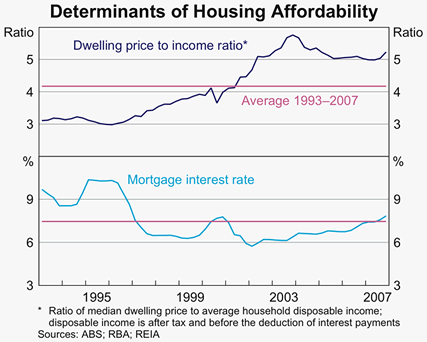 About a week ago, Demographia published their 7th Annual International Housing Affordability Survey. They picked up some press for finding that Sydney was the least affordable major housing market outside of Hong Kong, and Melbourne wasn’t that much better. Both were labelled “severely unaffordable”.
About a week ago, Demographia published their 7th Annual International Housing Affordability Survey. They picked up some press for finding that Sydney was the least affordable major housing market outside of Hong Kong, and Melbourne wasn’t that much better. Both were labelled “severely unaffordable”.
And while there is some irony in using the term “unaffordable” to describe the prices at which actual sales occurred (in any case, I agree that Australian capital city houses are expensive), it is the methodology of the survey that I want to nit-pick. It is based on a ratio that Demographia call the “Median Multiple”, which is calculated by dividing the median house (i.e. not apartment) sale price in that market for that period by the median household income for that market at that point in time. Apparently, such a measure is endorsed by such august bodies as the UN, the World Bank and Harvard.
I have previously talked about the mistakes that can be made in comparing two different medians, and it should be clear that there is no reason to assume any particular relationship between (say) today’s median Melbourne household income and the median sale price of a house in Melbourne over the last quarter. Ideally, the median should be calculated on the set of individual house affordability ratios, rather than a ratio calculated from the medians of two somewhat independent sets.
But the major issue I have with the report is that it picks, seemingly out of the air, the value “3.0” as value that separates unaffordable markets from affordable markets, as if it is some kind of universal constant. In fact, the value seems to be chosen principally because, in the past, affordability ratios were less than 3.0:
As Anthony Richards of the Reserve Bank of Australia has shown, the price to income ratio was at or below 3.0 in Australia, Canada, Ireland, New Zealand, the United Kingdom and the United States until the late 1980s or late 1990s, depending on the nation.
In fact, it should be clear that in a country like Australia, and specifically in cities like Melbourne, you would expect their Median Multiple figure to generally increase over time. Hence, there is no constant value that can be used for this ratio to indicate whether the housing market is out of whack.
For the Median Multiple to increase, basically median property values need to grow faster than median income. From my point of view, there are two obvious drivers for this growth to occur.
1. Gentrification
The Australian Housing and Urban Research Institute (AHURI) recently published a report on the gentrification of Melbourne and Sydney. (Essentially, this is when the existing residents of an area are displaced by a wealthier demographic.) For Melbourne, the regions of Maribyrnong and Northcote were identified as undergoing gentrification.
In such cases, property prices rise because people with higher incomes move into the neighbourhood. Actual incomes don’t necessarily rise at all – it’s just people moving around.
When an area has little ability to accommodate the displaced, e.g. through supporting greater housing density from subdividing lots or building apartment blocks, they need to find somewhere else to live. According to AHURI, displaced residents commonly relocate to an adjoining suburb (e.g. in 44% of cases of employed renters or 38% of owners). As they note, this in turn creates a “rippling effect” of gentrifying another region, and then another.
2. Trading Up
A major constraint to purchasing property is the ability to borrow money. First Home Buyers feel this pain worst of all, because (unless a significant deposit has been saved) they typically borrow between 80-90% of the purchase price.
However, everyone else in the market (by definition) has already purchased a home. So, when trading up, any additional amount to be borrowed will depend on the difference between the value of the current property and the value of the next.
Since banks limit the amount they lend based on a household’s income levels, clearly if a purchase relies principally on borrowing, it will be constrained by income level. But, if a purchase makes use of the equity in an existing home, it can go beyond income level.
Admittedly, this requires property values to grow, in order for the home owner to build up equity. So, it’s somewhat circular to argue that growth in property depends on growing property values. However, the growth in equity is typically much faster than the growth in the underlying property value, which is why subsequent properties can be purchased at a level equivalent to growth faster than income.
For example, a property purchased on a 10% deposit will, after five years, have had its equity grow the equivalent of about 30% per year, if the underlying property value grows just 5% per year for that period (assuming the mortgage isn’t paid down at all). Or more specifically, a $400k property on a $360k mortgage will end up as a $510k property with $150k of equity under those conditions. If the household income has also grown during that period, then the mortgage that could be serviced at the same level (as the mortgage at time of purchase) will have grown at the same rate. Putting that together with the increased equity is how the purchase price of the next home grows faster than income, while keeping the portion of income used to service the loans at about the same.
Australia has a large proportion of home owners as possessors of property. The recent AHURI policy bulletin on Australia’s changing patterns of home ownership noted that the home ownership level continued to remain around 70% of the population. Together with tax treatment that allows home owners to sell their property without any tax implications (versus, say, investors who would be up for GST), this creates an environment where trading up is encouraged.
Concluding remarks
So, if you’ve read this far, you’ll hopefully now agree that the Median Multiple price-to-income ratio is likely to increase over time in Australia, and hence there is no constant level of affordability that relates to it. 3.0 is not the magic number of affordability.
To conclude, I will leave you with a graph from an RBA speech on housing costs showing how, as you’d expect, the price-to-income ratio for Australian property has fluctuated, but trended up over the last 15 years (blue line).

